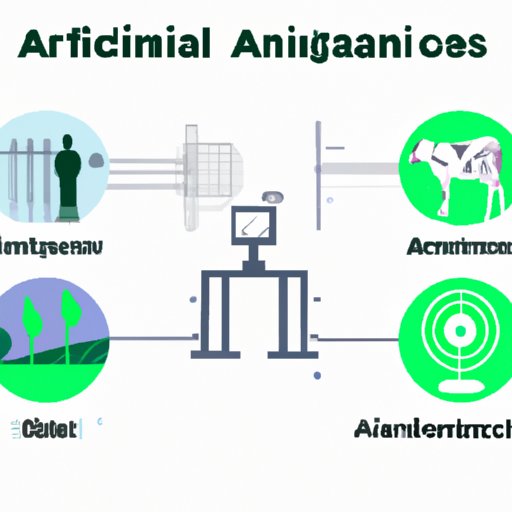Introduction
The agricultural industry is undergoing a digital transformation, with Artificial Intelligence (AI) being one of the most promising technologies to revolutionize modern farming. AI in agriculture refers to the use of machine learning algorithms and other AI-driven technologies for the purpose of optimizing farming operations and improving yields. This article will explore the various ways AI can be used in agriculture, as well as the potential benefits of doing so.

Utilizing AI for Crop Monitoring
AI can be used to detect diseases and pests in crops in order to prevent them from spreading. By leveraging computer vision and image recognition technology, AI-powered systems can analyze images of crops and identify signs of disease or pest infestation. This enables farmers to take preventive measures before the problem spreads and affects the yield.
In addition, AI can also be used to monitor soil conditions, such as moisture levels and nutrient content. By analyzing data from soil sensors, AI-powered systems can provide insights into when and how much fertilizer needs to be applied, helping farmers optimize their fertilization practices and maximize yields.
The benefits of utilizing AI for crop monitoring include improved yields, reduced costs, and reduced chemical inputs. AI-driven systems can help farmers make more informed decisions that lead to better crop health and increased yields, while also reducing the amount of time, money, and resources spent on crop management.
Enhancing Irrigation Efficiency with AI
AI can also be used to optimize water usage for agriculture. By leveraging predictive analytics, AI-powered systems can analyze data from weather forecasts and soil sensors to determine when and how much water should be used for irrigation. This helps farmers use water more efficiently, which can lead to higher yields and lower water bills.
AI-driven systems can also be used to monitor water levels in rivers and reservoirs, enabling farmers to plan irrigation schedules accordingly. This helps ensure that crops get the right amount of water at the right time, leading to better yields and reduced water wastage.
The benefits of using AI for irrigation efficiency include improved water conservation, reduced water costs, and higher yields. By using AI-driven systems to monitor and manage irrigation, farmers can save water, reduce their water bills, and maximize their yields.
Implementing AI-Powered Precision Farming
AI can also be used to maximize yields through data-driven decision making. By leveraging big data analytics, AI-powered systems can analyze vast amounts of data from sensors, satellites, and other sources to provide insights into crop health, soil conditions, and other factors that affect yields. This helps farmers make better decisions about when and how to cultivate their crops, leading to increased yields.
In addition, AI-driven systems can also be used to optimize fertilization and pesticide application. By analyzing data from soil sensors and satellite imagery, AI-powered systems can provide insights into when and how much fertilizer or pesticides need to be applied, helping farmers reduce chemical inputs and maximize yields.
The benefits of using AI for precision farming include improved yields, reduced costs, and minimized environmental damage. By leveraging AI-driven systems to optimize their farming practices, farmers can achieve higher yields while also reducing their costs and minimizing their environmental impact.

Leveraging AI for Automated Harvesting
AI can also be used to automate the harvesting process. By leveraging robotics and computer vision technology, AI-powered systems can detect ripe crops and automatically harvest them, eliminating the need for manual labor. This helps reduce labor costs and increase efficiency, enabling farmers to maximize their yields.
In addition, AI-driven systems can also be used to sort harvested crops. By analyzing images of harvested crops, AI-powered systems can detect defects and separate good crops from bad ones, leading to better quality produce and higher yields.
The benefits of using AI for automated harvesting include improved efficiency, reduced labor costs, and higher yields. By leveraging AI-driven systems to automate the harvesting process, farmers can save time and money while maximizing their yields.

Employing AI for Livestock Management
AI can also be used to monitor livestock health and wellbeing. By leveraging sensors and computer vision technology, AI-powered systems can detect changes in animal behavior and alert farmers when something is wrong. This helps farmers take preventive measures to protect their livestock, leading to healthier animals and higher yields.
In addition, AI-driven systems can also be used to monitor feed consumption. By analyzing data from feed sensors, AI-powered systems can determine when and how much feed needs to be given to animals, helping farmers optimize their feeding practices and maximize yields.
The benefits of using AI for livestock management include improved animal health, reduced costs, and higher yields. By leveraging AI-driven systems to monitor their livestock, farmers can keep their animals healthy while also reducing their costs and maximizing their yields.
Conclusion
AI has the potential to revolutionize the agricultural industry by optimizing farming operations and increasing yields. This article explored the various ways AI can be used in agriculture, such as crop monitoring, irrigation efficiency, precision farming, automated harvesting, and livestock management. The benefits of using AI in agriculture include improved yields, reduced costs, and minimized environmental damage.
As AI technologies continue to develop and become more accessible, they will become increasingly important for modern farming. By leveraging the power of AI, farmers can optimize their operations and maximize their yields, leading to a brighter future for the agricultural industry.
(Note: Is this article not meeting your expectations? Do you have knowledge or insights to share? Unlock new opportunities and expand your reach by joining our authors team. Click Registration to join us and share your expertise with our readers.)
